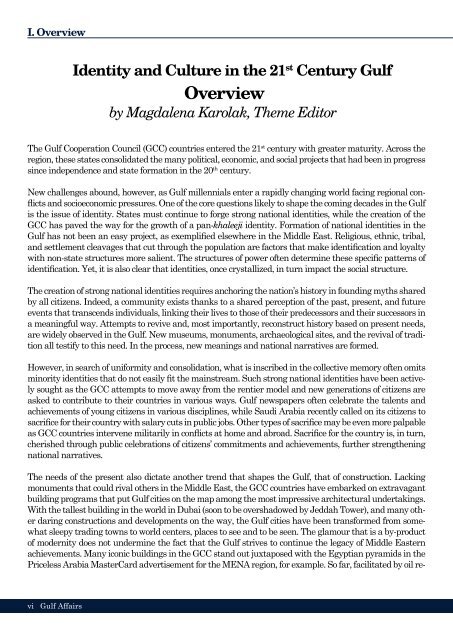You also want an ePaper? Increase the reach of your titles
YUMPU automatically turns print PDFs into web optimized ePapers that Google loves.
I. Overview<br />
<strong>Identity</strong> and <strong>Culture</strong> in the 21 st Century Gulf<br />
Overview<br />
by Magdalena Karolak, Theme Editor<br />
The Gulf Cooperation Council (GCC) countries entered the 21 st century with greater maturity. Across the<br />
region, these states consolidated the many political, economic, and social projects that had been in progress<br />
since independence and state formation in the 20 th century.<br />
New challenges abound, however, as Gulf millennials enter a rapidly changing world facing regional conflicts<br />
and socioeconomic pressures. One of the core questions likely to shape the coming decades in the Gulf<br />
is the issue of identity. States must continue to forge strong national identities, while the creation of the<br />
GCC has paved the way for the growth of a pan-khaleeji identity. Formation of national identities in the<br />
Gulf has not been an easy project, as exemplified elsewhere in the Middle East. Religious, ethnic, tribal,<br />
and settlement cleavages that cut through the population are factors that make identification and loyalty<br />
with non-state structures more salient. The structures of power often determine these specific patterns of<br />
identification. Yet, it is also clear that identities, once crystallized, in turn impact the social structure.<br />
The creation of strong national identities requires anchoring the nation’s history in founding myths shared<br />
by all citizens. Indeed, a community exists thanks to a shared perception of the past, present, and future<br />
events that transcends individuals, linking their lives to those of their predecessors and their successors in<br />
a meaningful way. Attempts to revive and, most importantly, reconstruct history based on present needs,<br />
are widely observed in the Gulf. New museums, monuments, archaeological sites, and the revival of tradition<br />
all testify to this need. In the process, new meanings and national narratives are formed.<br />
However, in search of uniformity and consolidation, what is inscribed in the collective memory often omits<br />
minority identities that do not easily fit the mainstream. Such strong national identities have been actively<br />
sought as the GCC attempts to move away from the rentier model and new generations of citizens are<br />
asked to contribute to their countries in various ways. Gulf newspapers often celebrate the talents and<br />
achievements of young citizens in various disciplines, while Saudi Arabia recently called on its citizens to<br />
sacrifice for their country with salary cuts in public jobs. Other types of sacrifice may be even more palpable<br />
as GCC countries intervene militarily in conflicts at home and abroad. Sacrifice for the country is, in turn,<br />
cherished through public celebrations of citizens’ commitments and achievements, further strengthening<br />
national narratives.<br />
The needs of the present also dictate another trend that shapes the Gulf, that of construction. Lacking<br />
monuments that could rival others in the Middle East, the GCC countries have embarked on extravagant<br />
building programs that put Gulf cities on the map among the most impressive architectural undertakings.<br />
With the tallest building in the world in Dubai (soon to be overshadowed by Jeddah Tower), and many other<br />
daring constructions and developments on the way, the Gulf cities have been transformed from somewhat<br />
sleepy trading towns to world centers, places to see and to be seen. The glamour that is a by-product<br />
of modernity does not undermine the fact that the Gulf strives to continue the legacy of Middle Eastern<br />
achievements. Many iconic buildings in the GCC stand out juxtaposed with the Egyptian pyramids in the<br />
Priceless Arabia MasterCard advertisement for the MENA region, for example. So far, facilitated by oil re-<br />
vi Gulf Affairs


